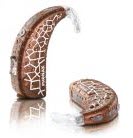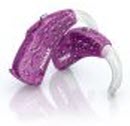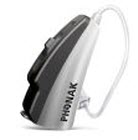Interview with Christine Jones, Au.D., National Manager of Pediatrics, Phonak US
Share:
Topic: Phonak's Pediatric Portfolio

Christine Jones
CAROLYN SMAKA: Thanks for your time today, Christine.
Phonak has a very comprehensive portfolio of hearing instruments, many of which are appropriate for children, so why a dedicated pediatric portfolio?
CHRISTINE JONES: The idea behind Phonak's pediatric portfolio was to develop a line of instruments that were specialized for the pediatric population. We are now completing the second generation of the pediatric portfolio, the Spice+ Platform Portfolio. Rather than needing to search through the entire Phonak catalog of more than 30 instruments in order to determine what device would be best for a child, we've pared it down to the few that are uniquely designed to meet the needs of children. Any child that walks through the door with hearing loss can be ideally fit with one of these devices.
SMAKA: What products are included in Phonak's pediatric portfolio?

Naída S is available in both super power and ultra power version to meet the needs of children who require power devices
JONES: The Naída S is our second generation Naída product and it is the power device in the pediatric portfolio. The designation "S" indicates that it is now on the Spice platform. It is available in both a super power and an ultra power version to meet the needs of all power users. We recently launched Nios S H20 which is a water resistant pediatric micro-BTE. The Nios S H20 is designed for mild to moderately-severe hearing loss.
SMAKA: What does "micro" mean in terms of pediatric instruments? Many "micro" instruments for adults do not have features that I would think are needed for children.
JONES: In addition to small size, we believe there are some other requirements that should be staples for a micro BTE, or any instrument, being fitted on children. Ear-level DAI capability is one of those requirements. All of the instruments in our pediatric portfolio are compatible with an integrated FM receiver. We also know that schools often have a supply of universal FM receivers for students, and so we ensure that all of the products in the pediatric portfolio are also universal FM compatible.
For pediatric micro instruments, universal FM compatibility means that the BTE must use a size 13 battery instead of a size 10 or 312, in order to adequately power the hearing instrument along with any FM system that may be coupled to it. Due to size and safety considerations when fitting young children, we also do not want any electrical parts such as receivers, in the ear, so the standard pediatric portfolio does not include RIC products.
SMAKA: Water resistance must be very important in pediatric fittings. Can you tell me more about the new Nios S H20?

Nios S H20 is water resistant, and has achieved the IP rating of 67, meaning it can be submerged in water for up to 30 minutes without being damaged.
JONES: Durability is certainly another consideration when selecting instruments for children. The Nios S H2O has earned the Ingress Protection (IP) rating of 67. The first number in the IP rating denotes the device's resistance to particulates like dust and sand, and 6 is the highest rating possible. The second number is the device's resistance to water and moisture, and 8 is the highest rating possible. Nios S H20 is intended to be worn all day for any activities. We know that children learn by playing and through their experiences. If wearing hearing instruments prohibits a child from playing in a sandbox, taking swimming lessons, having a good time in the bathtub, going to soccer practice on a rainy day, etc. then the hearing instruments are inhibiting the child from learning.
It is our goal at Phonak to make hearing instruments that are the entry point for life and learning and communicating, and not a barrier. All of the products in the pediatric portfolio are water resistant, and our newest addition, Nios S H20, has the highest IP rating given to any BTE hearing instrument.
SMAKA: We see the terms 'water resistant' and 'waterproof' both used in the industry today. Is there a difference?
JONES: I think whenever you see terms like that, it's important to quantify what they mean and look for the specific data behind them. The IP rating is the objective, standardized way for rating water resistance in consumer products. In regards to Nios S H20, the six rating means that it is dust-tight. After a standardized battery of tests, there was no ingress or introduction of dust to the electronics of the device. The second rating refers to resistance to liquids. For instance, a rating of four would mean that you could splash some water on the device. A five rating means the device could sustain being hit with water jets;for a six rating, more powerful water jets are used. Nios S H20 received a rating of seven, meaning that the device can be continuously immersed for 30 minutes without damage to the device.
Another consideration when comparing devices that use these terms is if there is sacrifice to sound quality or acoustics as a result of the waterproofing. With Nios S H20, we consider it a daily use hearing instrument. It has all of the qualities, capabilities and features of a device that you would expect the child to wear every day of the week, and therefore the water resistance comes without any acoustical compromises.
SMAKA: Looking to the data is great advice. My next question is in regard to the Spice+ platform. What does that provide?
JONES: The Spice+ platform introduced a new chip with the capability to implement new features that we have never been able to offer before, such as those features based on binaural streaming. We can transmit full bandwidth audio between the ears real time.
This allows for a number of features, including, StereoZoom, DuoPhone autoZoomControl, and CROS/BiCROS mode.
StereoZoom is a super directionality for very noisy, challenging listening environments. This mode generates the narrowest beam to really focus in on one or two people, such as when you're having a conversation at a noisy party or at a busy reception.
With DuoPhone, when you bring the telephone to one ear, you will hear the signal on both sides, providing a binaural advantage on the telephone. It is much obviously much easier to understand over the telephone when you're hearing the signal in both ears. This feature can also simultanously reduce interference from the off-side ear, allowing the person to concentrate on the phone conversation.
ZoomControl allows you to steer your directionality in different directions. Typically, directional microphones do a great job of improving listening in noise when the signal is coming from the front and competing sounds are coming from behind.
But there are many environments that hearing instrument users still struggle with that don't meet that criteria. One example of such a situation would be driving a car and trying to listen to a passenger in the back seat. A traditional directional microphone will be of very little help in that situation, but with ZoomControl, you can steer the directionality to focus on the passenger behind you.
Alternately, with autoZoomControl, the device self-steers. It picks up the location with the highest signal-to-noise ratio, zooms in that direction, and then moves according to where the signal moves.
And of course, we can't talk about Phonak instruments without mentioning Sound Recover. Since this is still one of our most valuable features, capturing the interest of clinicians and researchers alike, it is available in every Spice instrument.
These are just some of the key features with the Spice+ platform.
SMAKA: What is available from Phonak for teens or young adults?

Audéo S SMART is a small, stylish wireless RIC device for teens as well as adults
JONES: As an addendum to the pediatric portfolio, we have two options for teens and young adults, the Audéo S SMART and the Naída CRT. The Naída CRT is a new solution from Phonak that features the power of Naída in a RIC style device. It uses the same BTE housing as the Nios S, with a canal receiver. There is a choice of three receivers - standard, power and super power. The super power receiver has a 2cc gain and output of 65/133.
SMAKA: That is pretty powerful. In addition to products, Phonak has always been known for its pediatric resources from software, to tools to conferences. What's new in this regard?
JONES: We have some news I'm pretty excited about. Since the launch of SoundRecover, clinicians have expressed great interest in getting more tools to assess the impact of some of these newer, state-of-the-art hearing aids and new technologies by behavioral means. To aid in clinical decision making, Phonak has licensed the University of Western Ontario (UWO) Plurals Test. This is a very simple test that can be administered to clients of any age. It is highly sensitive to the impact of SoundRecover and can be used for comparing across devices, between features and to measure performance over time.
As a profession, we have good protocols for using electroacoustic measures to evaluate and optimize hearing aid technologies. But until now there weren't a lot of clinical measures that were sensitive to the effects of newer technology such as SoundRecover, which mainly has an impact on audibility and one's use of high frequencies. The UWO Plurals Test is a well-validated test that's been used in numerous published research studies for evaluating the effect of SoundRecover. We've collaborated with UWO to further develop it into a clinical tool that can be very easily administered in the office.
SMAKA: The UWO Plurals Test can be obtained through Phonak?
JONES: Yes. It includes the audio files, scoring sheets, and a set of picture pointing cards so that it can be used even with very young children.
It's easy to use and quick to administer. The UWO Plurals Test also provides us with a way to show the child's challenges and performance changes in a way that is easily understood by parents. Results of electroacoustic testing don't translate well to counseling and is often not meaningful to parents.
Also, in terms of support we have the Junior Mode in our fitting software, which is an evidence-based approach to pediatric things. It helps to streamline the settings right out of the gate so that clinicians don't need to make a lot of changes in order to optimally adapt hearing instruments to children. For instance, in Junior Mode, the default fitting formula is DSL 5 and the default setting of FM + M is always a part of the hearing instrument program so pediatric devices are automatically "FM-ready." We've also included reports that can be generated at the end of the fitting. They are customized to the child's devices, the child's hearing loss, and the intended audience for the report. There is a set of reports that target parents and caregivers, a set for teachers, and as the child approaches the teen years, there is even a set for the child himself to start learning about his device and hearing loss. We want to help clinicians to develop those self-advocacy skills!
SMAKA: I heard the GAP program was recently updated.
JONES: Yes, speaking of self-advocacy, the GAP program, which stands for Guide to Access Planning, was developed by Phonak with the leadership of Dr. Cheryl Deconde Johnson, Dr. Carrie Spangler, and Solange Anderson and has been recently updated. It is a tool that educators, therapists and parents can use to help ease the transition for children going from high school to further education or into the workforce. There is also a segment geared towards the teen himself or herself. The GAP program includes a huge resource of tools to help plan this transition because we know that it is a time when a lot of children with hearing loss struggle, and can fall through the cracks. The GAP program can help to plan the considerations, the advocacy, and the knowledge base that it will take to successfully accomplish these life transitions. It has been edited and improved, and there are some new tools in the program that will be launched soon. The latest version is also web-based, so it can be accessed on the Phonak website from any computer, iPad or mobile device.
SMAKA: Great to hear about all the new things happening. Where can professionals go for further details?
JONES: For further information, please visit our website, www.phonak.com. In addition to product and software training on AudiologyOnline, we have a monthly pediatric seminar series where we cover various topics in pediatrics such as products, support tools, and challenges in pediatric audiology. We also invite guest speakers to these sessions, such as Erin Schafer, Linda Thibodeau, Jace Wolfe and other leading experts. It is a great resource for professionals to obtain more information not just regarding our products and services, but on a range of other topics in pediatric audiology.
SMAKA: Christine, thanks again for your time today. It was great catching up.
JONES: Thank you, Carolyn.
To learn more about Phonak, please visit the Phonak web channel on Audiology Online.


